Please click here to access the main AHDB website and other sectors.
- Home
- Knowledge library
- Control measures used within the Tuta absoluta IPM strategy
Control measures used within the Tuta absoluta IPM strategy
Read about the specific control measures used within the Tuta absoluta IPM strategy, which developed in just four years via AHDB-funded projects led by the TGA.
Macrolophus pygmaeus
Macrolophus pygmaeus is the primary biocontrol agent in this IPM strategy. Both adults and nymphs are voracious predators capable of probing into leaf tissue to kill Tuta absoluta larvae.
Establishing the predator
The predator should be released at the rate of 1 per m2 as soon as possible after the plants are brought into the production glasshouse. However, it may be late spring before there are sufficient predators to provide acceptable control of the pest. The provision of supplementary food in the form of Ephestia (a stored product moth) eggs enhances the speed of establishment when pest numbers are small.
Managing Macrolophus populations
Very large populations of Macrolophus pygmaeus often develop during the summer. After the pest is under control and there is a general shortage of invertebrate prey, the predator may turn its attention to the plants causing damage to leaves and trusses. Under these circumstances, the predator population can be culled with natural pyrethrins.
Harvesting Macrolophus
Where numerous, Macrolophus pygmaeus can be collected and redistributed to areas of need.
Read more about harvesting Macrolophus in the factsheet: Boosting biocontrols within IPM programmes
Macrolophus on a tomato
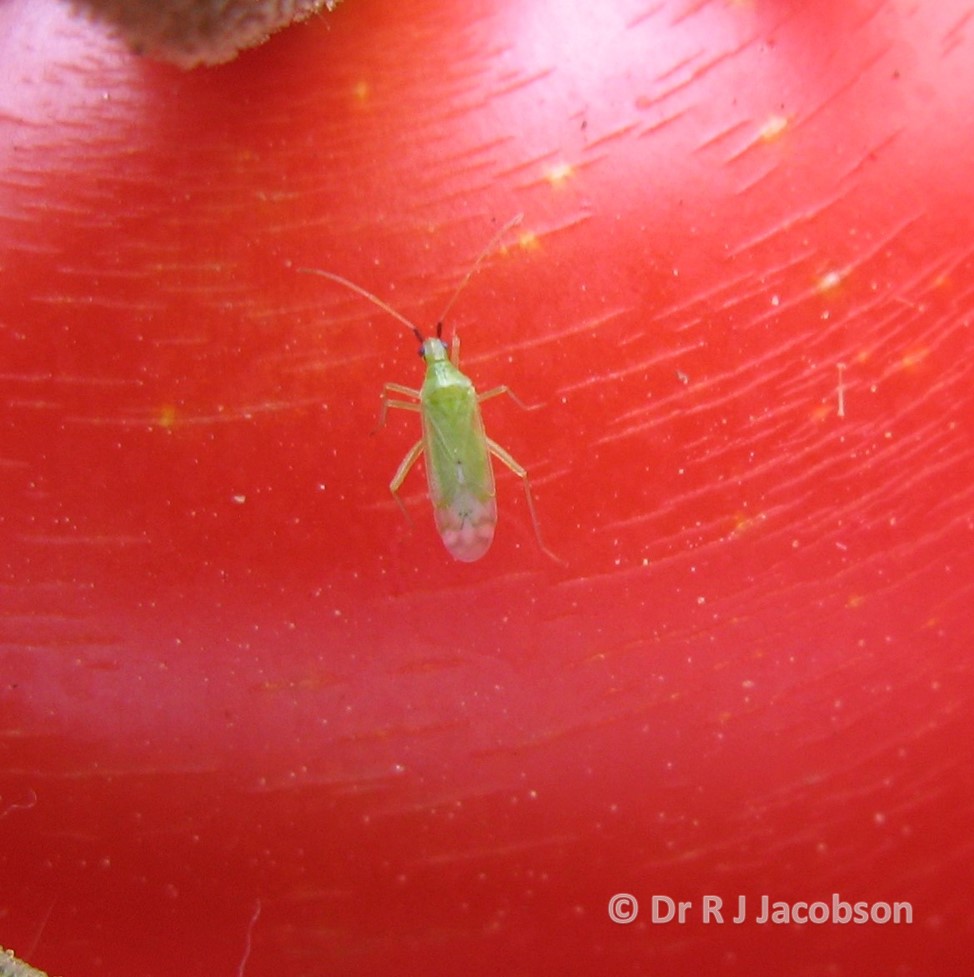
Image © Rob Jacobson Consultancy Ltd.
Tuta absoluta mating disruption technique
Female Tuta absoluta produce a pheromone to attract male moths prior to copulation. The mating disruption technique involves artificially saturating the glasshouse atmosphere with a synthetic version of this attractant to confuse the males.
Applying the pheromone
The pheromone is incorporated into lace-like plastic dispensers, which are distributed at the rate of 800–1,000 per hectare. The pheromone is heavier than air and will cascade down through the crop canopy if the dispensers are hung on crop wires. They persist for 110–160 days depending on temperature. Up to three applications are permitted per crop. Read more detail in the project report Addressing important knowledge gaps in the Tuta absolula IPM programme.
Parthenogenesis
There is a possibility that this technique may select for females that exhibit parthenogenesis (the ability to produce eggs without mating).
Tuta absoluta mating
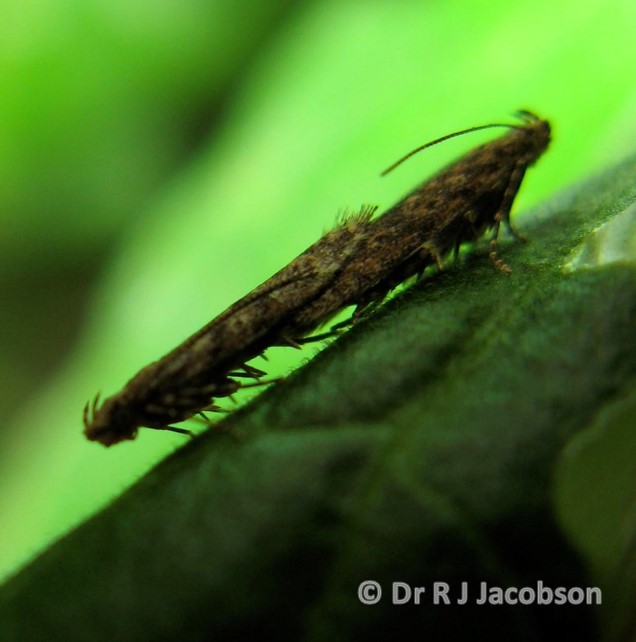
Image © Rob Jacobson Consultancy Ltd.
Spinosad via the irrigation system
Spinosad, which is derived from naturally occurring soil fungi, may be applied via the irrigation system before the first caterpillars complete their development.
Trials results
Commercial crop-scale trials have shown that this treatment can suppress the pest’s population growth for over six weeks in rockwool, coir and NFT-grown crops, and for 3–4 weeks in soil-grown crops. The latter may vary in different soil types. Up to three applications are permitted per crop.
Resistance to spinosad
Some Tuta absoluta populations have developed resistance to this insecticide. Alternative products are under development – watch this space for updates.
Irrigator with spinosad
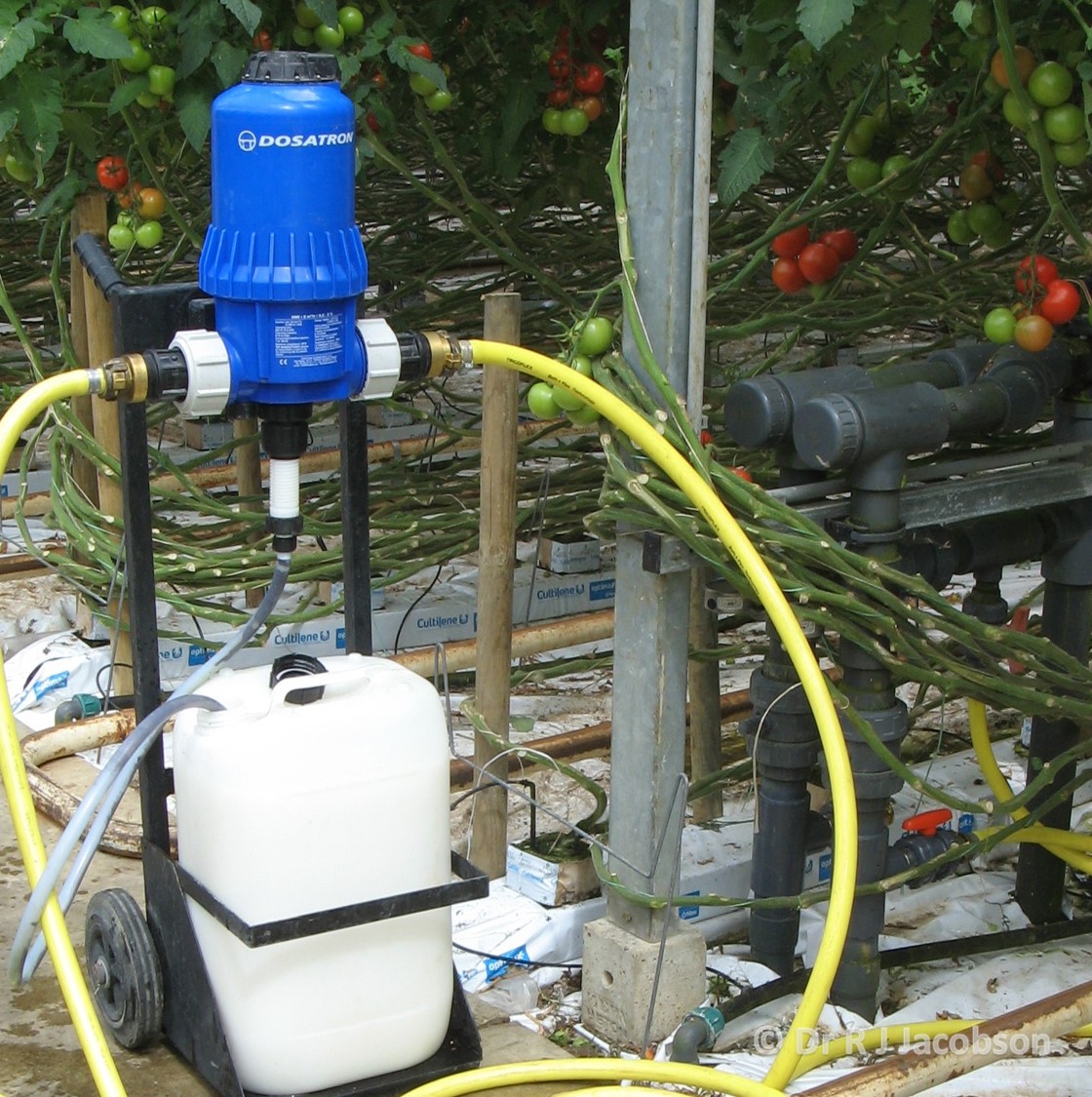
Image © Rob Jacobson Consultancy Ltd.
Physical control measures
The main early season control measures may be supplemented by physical controls, for example:
Sticky floor treatments
Sticky treatments, applied to the plastic floor covering beneath raised gutters, intercept many larvae as they drop to pupate.
Light traps
The main early season control measures may be supplemented by physical controls, for example:Various types of UV light traps have been shown to be attractive to both male and female moths. The traps either incorporate a sticky base or an electrocutor to kill the insects.
What is the impact?
Although many insects are trapped by these physical methods, it is difficult to quantify the contribution to the overall control programme.
Sticky treatment applied to the plastic floor covering, with caught insects.
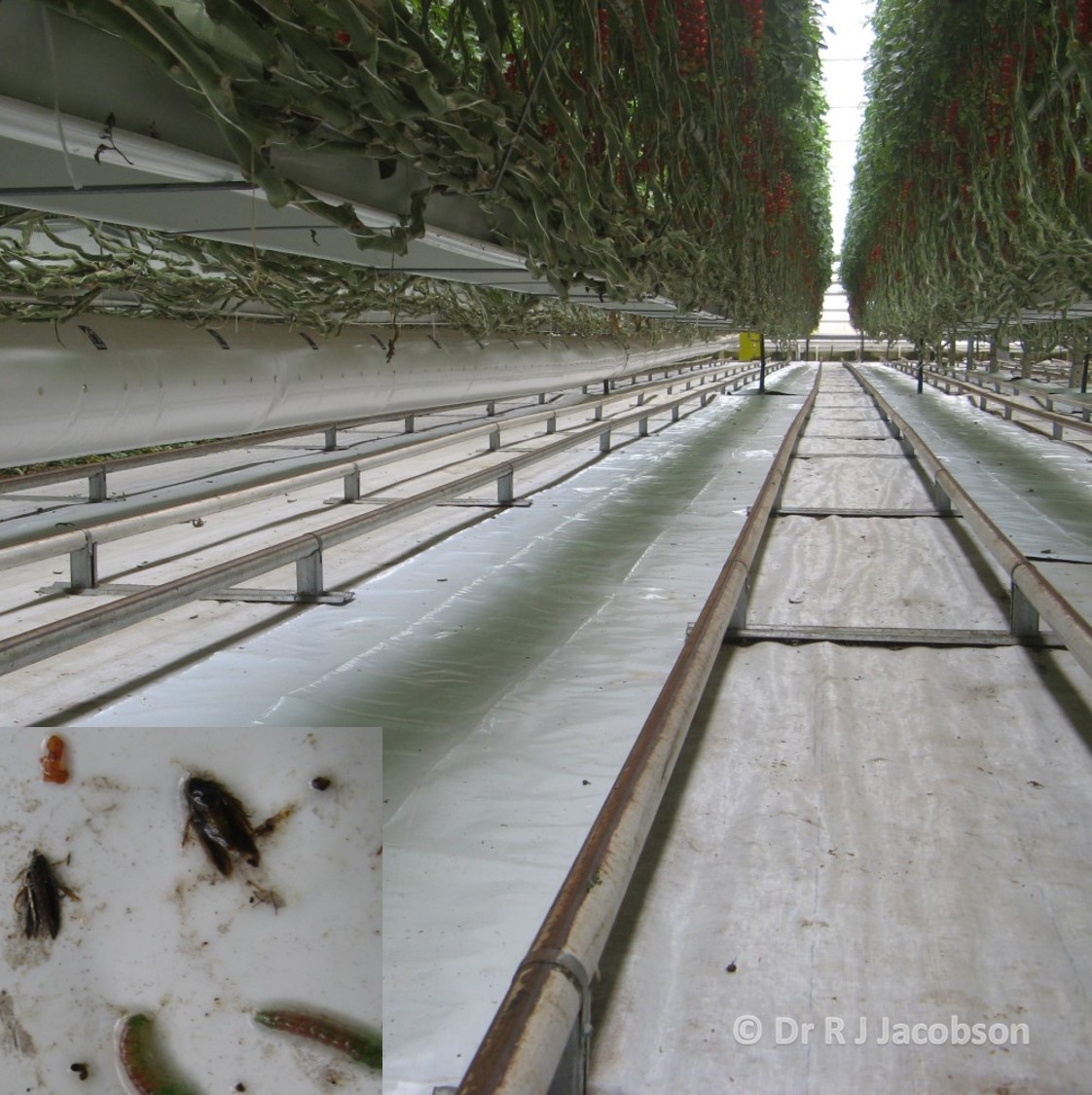
Image © Rob Jacobson Consultancy Ltd.
Second line of defence (SLoD) treatments
A SLoD treatment is used to adjust the balance between pest and beneficial populations when conditions favour the pest. It slows the pest’s population growth, allowing the beneficial species to ‘catch up’. For a product to be useful as a SLoD treatment against Tuta absoluta, it should be systemic (or at least translaminar) to reach the larvae within the plant. Ideally, it should be quick to apply and to act, which usually means a spray application. It must also be compatible with the primary biological control agents. Efficacy is important but 50–60% reduction of the pest population is often enough to support the primary control measure.
Chemical insecticides
Spinosad
Although spinosad meets all the criteria listed above, it should not be used as a SLoD if it has already been used via the irrigation earlier in the season. Resistance (link to subpage 6 - Insecticide resistance in Tuta absoluta – link pending) to this chemical is already known, so an alternative insecticide should be selected.
Chlorantraniliprole
This IPM-compatible target-specific insecticide should be an ideal choice because it belongs to a different chemical group from spinosad. However, care must also be taken with this product because resistance has been reported in some Tuta absoluta populations. This IPM-compatible target-specific insecticide should be an ideal choice because it belongs to a different chemical group from spinosad.
Azadirachtin
This insecticide was approved for this purpose in the UK in 2020. However, trials are still underway to determine how to obtain the best results within this IPM programme – watch this space for updates.
Vertical boom sprayer in crop
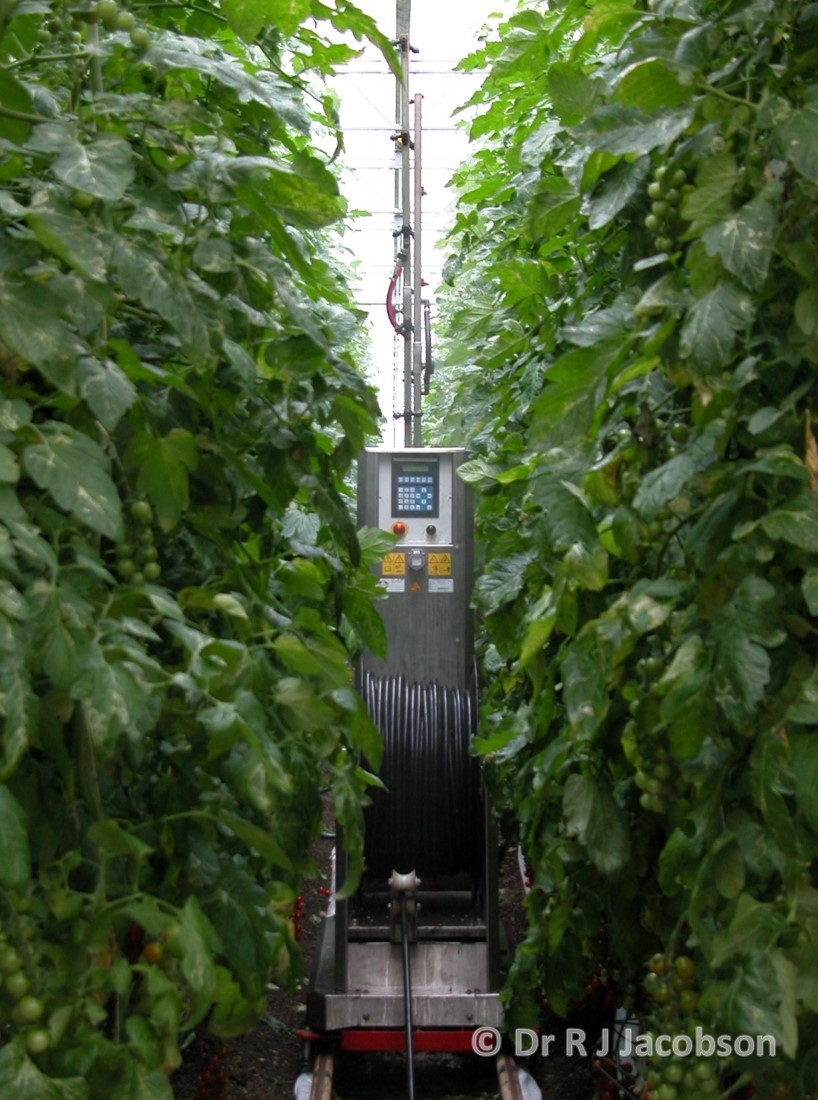
Image © Rob Jacobson Consultancy Ltd.
Entomopathogenic nematodes
The entomopathogenic nematodes, Steinernema feltiae (as Nemasys®), have provided 40–50% control of medium-sized Tuta absoluta larvae when sprayed to the point of foliar run-off at the rate of 1 million infective juveniles per litre.
Optimising results
The best results have been achieved at high pest population densities as the leaf damage allows more entry points for the nematodes. It is probably necessary to apply a series of 2–3 treatments at 7–10-day intervals to provide adequate suppression of the pest.
An option for organic crops
This can be a useful option for growers of organic crops who are not allowed to use synthetic insecticides.
Nematodes
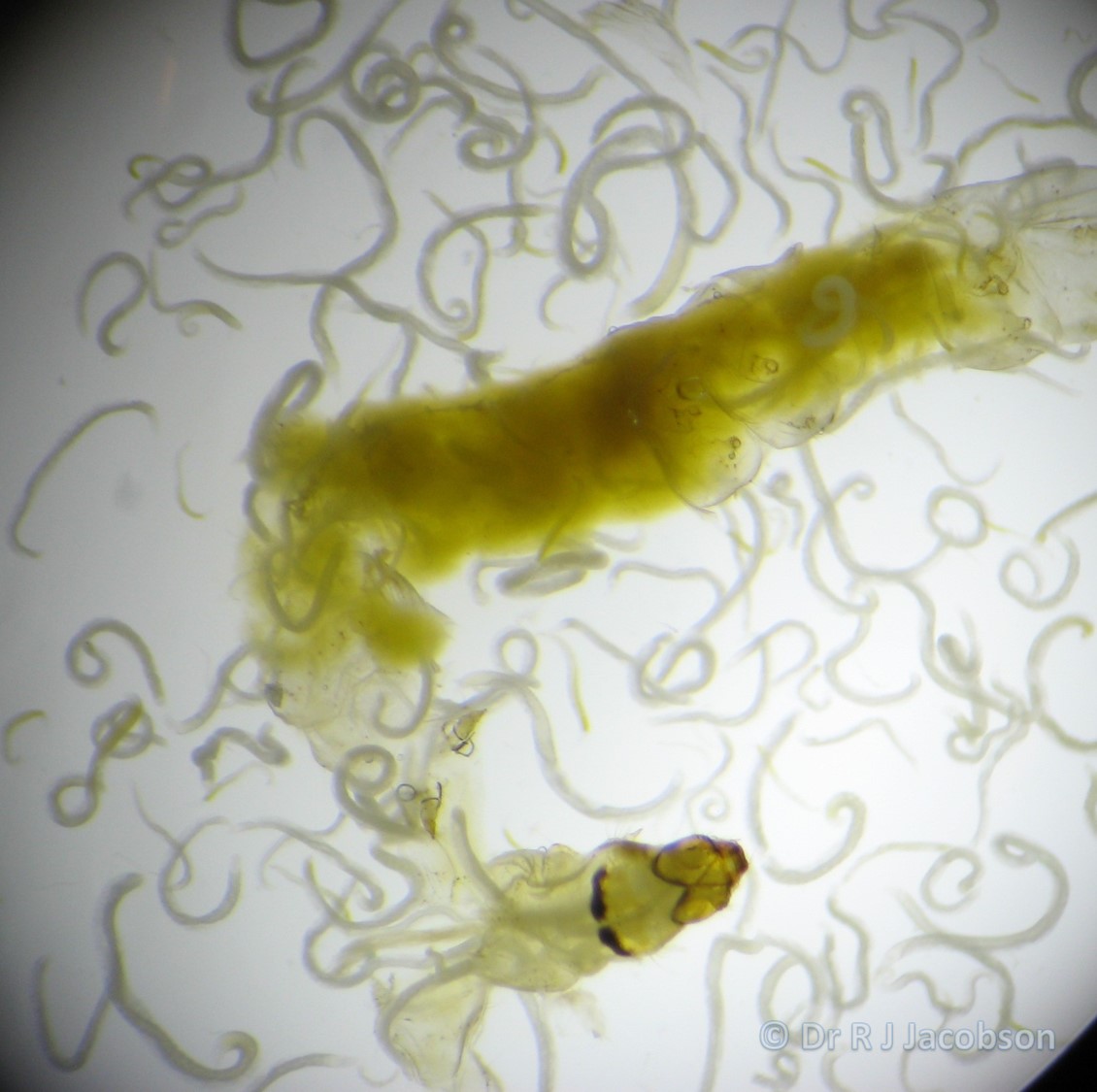
Image © Rob Jacobson Consultancy Ltd.
Control of grazing larvae
Young Tuta absoluta larvae are vulnerable to contact insecticides and biopesticides when they are grazing in the head of the plant.
Bacillus thuringiensis
This biopesticide doesn’t penetrate plant tissue but can provide useful control of young larvae under these circumstances. At least 3 applications at 7–10-day intervals are usually required to suppress the pest’s population growth.
IPM-compatible insecticide
Azadirachtin was approved for this purpose in the UK in 2020. However, trials are still underway to determine how to obtain the best results within this IPM programme in commercial-scale tomato crops – watch this space for updates.
Using Bacillus thuringiensis to help control Tuta absoluta
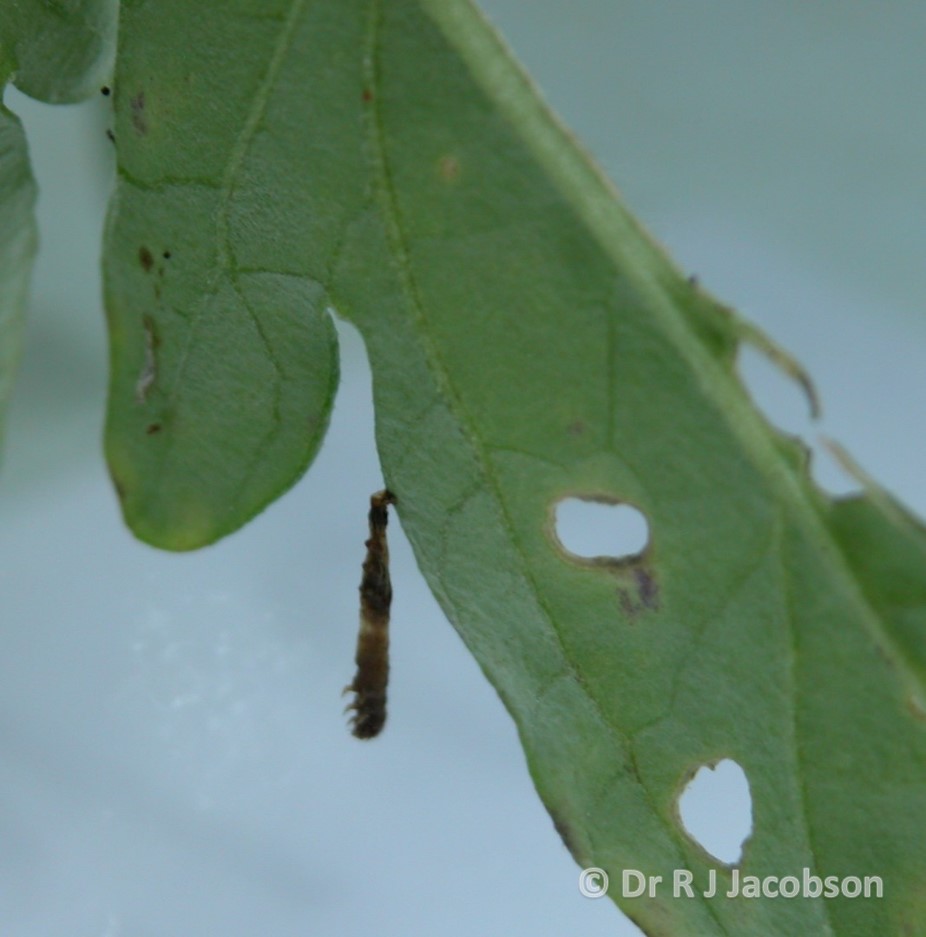
Image © Rob Jacobson Consultancy Ltd.
Additional considerations for IPM in all-year-round crops
AYR crops are grown with supplementary lighting when natural light is limiting. They are often planted within, or alongside, mature crops, with large pest populations resulting in greater pest invasion of the new crop.
Mating disruption
The mating disruption technique seems to be less effective when the initial pest density is high.
Prompt action
Early intervention with an effective insecticide may be required before releasing biological control agents. This must take into account the resistance status of that pest population.
Harvesting biocontrols
The neighbouring mature crops may also be a source of surplus beneficial insects, which can be collected for release in the new crop. This will allow much larger numbers to be released than normal.
Useful links
Learn about insecticide resistance in Tuta absoluta
Read more about harvesting Macrolophus in the factsheet: Boosting biocontrols within IPM programmes
Find more news and information on integrated pest management via our IPM hub
Author
The content on this page was authored for AHDB by Dr Rob Jacobson (Rob Jacobson Consultancy Ltd).
Acknowledgements
AHDB is grateful to all the TGA members who contributed to the trials that developed the current IPM strategies. Particular thanks to Peter Bell, Richard Bezemer, Colin Bridges, Roly Holt, Paul Howlett, Brian Moralee and Phil Morley, as well as our overseas colleagues at Horticilha, Portugal.
Disclaimer
This information on this page has been collated using information from the Health and Safety Executive (HSE) website (pesticides.gov.uk) and from product labels and supplier technical leaflets. Important – regular changes occur in the approval status of plant protection products, arising from changes
in the legislation or for other reasons. For the most up-to-date information, please check the HSE website or with a professional supplier or BASIS-qualified consultant, as information could have changed since the publication of this page.
Growers must hold a paper or electronic copy of an EAMU before using any product under the EAMU arrangements. Any use of a plant protection product via an EAMU is at the grower’s own risk.
Always follow approved label or EAMU recommendations, including rate of use, maximum number of applications per crop or year, and where crop safety information is not available, test the product on a small number of plants to determine crop safety prior to widespread commercial use.
If in doubt about which products are permissible on protected edibles or how to use them correctly, seek advice from a BASIS-qualified consultant.
Topics:
Sectors:
Tags:

